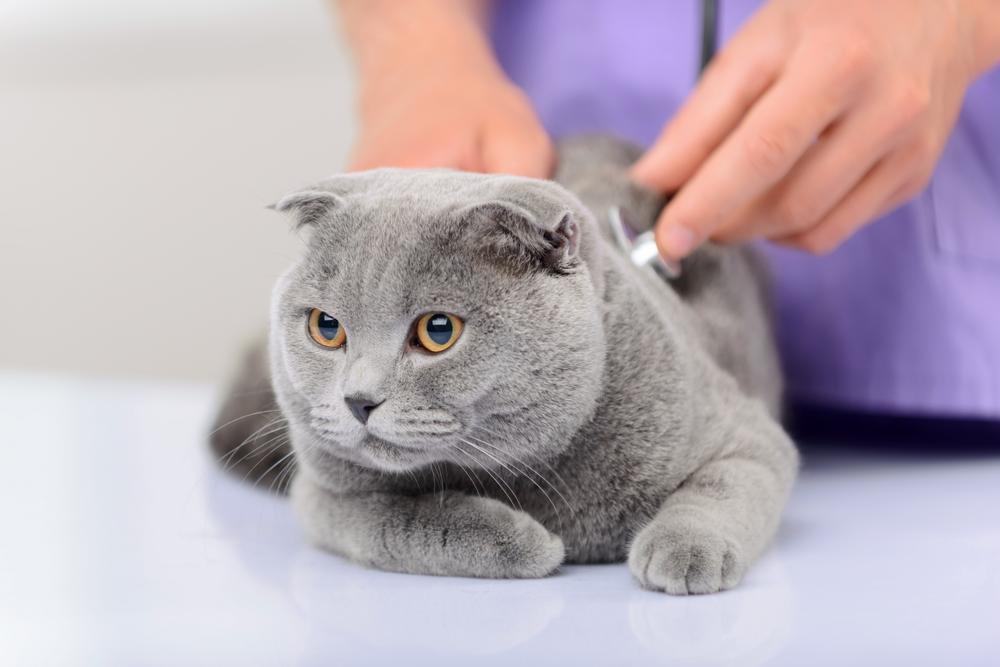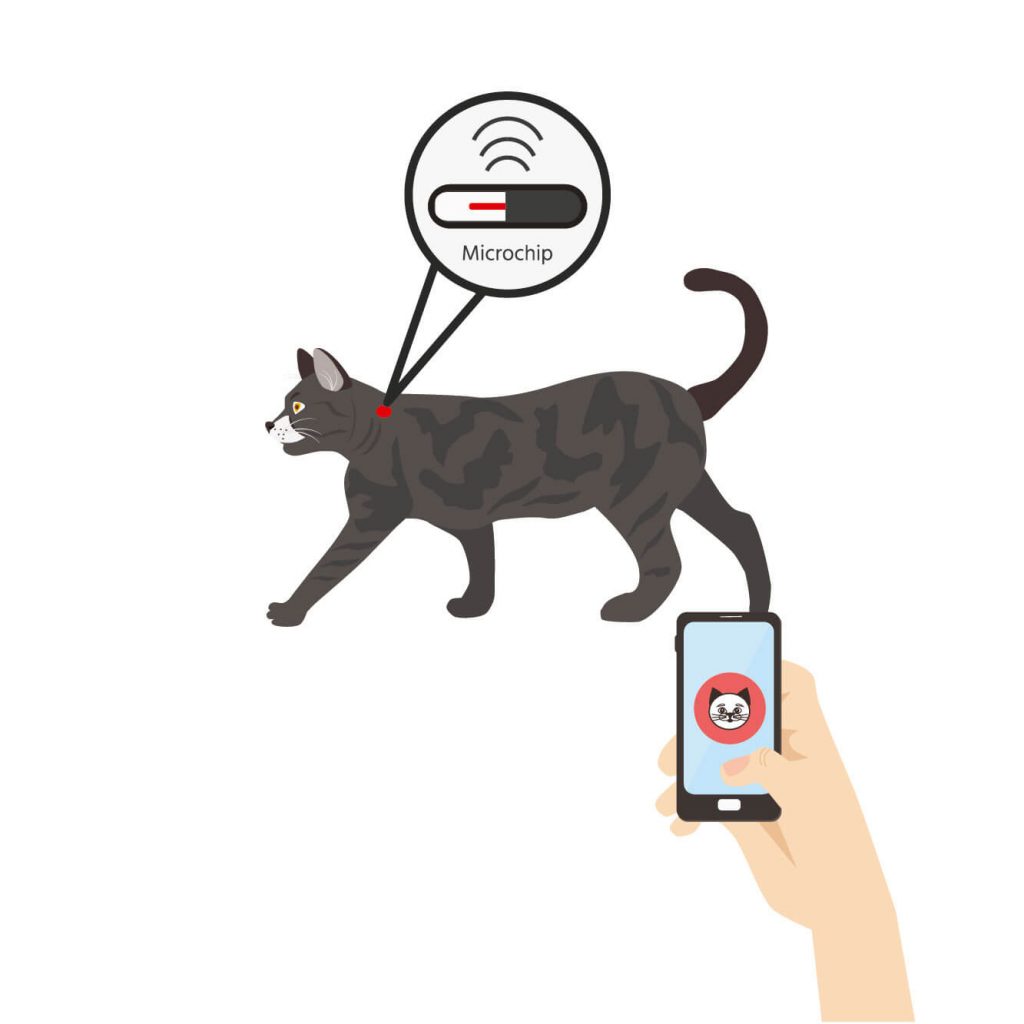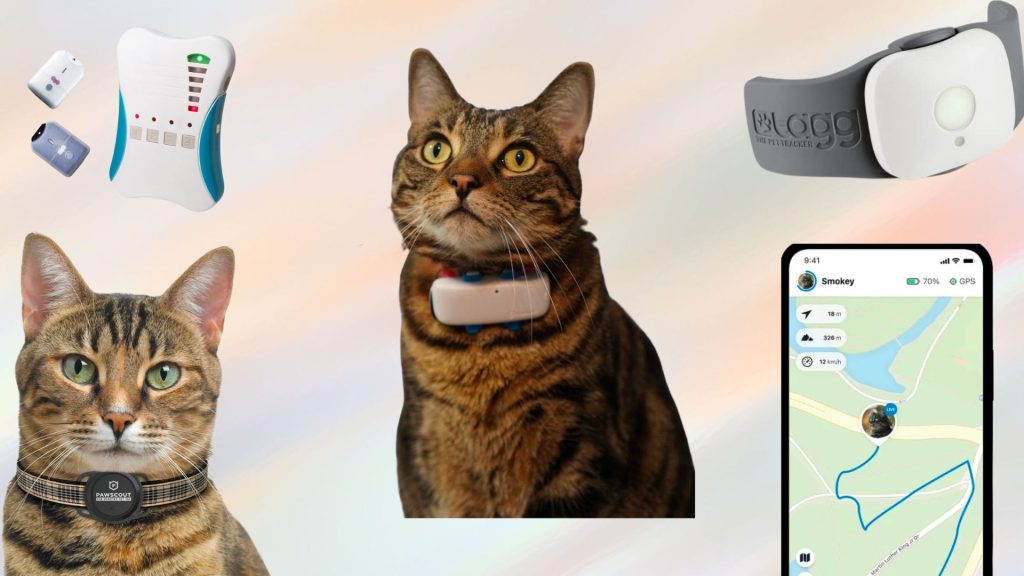Table of Contents
Chipping a cat
Learn how to locate a microchipped cat. From scanning procedures to contacting relevant authorities, ensure a swift reunion with your beloved feline companion.
No matter whether you have an indoor or outdoor cat, you should definitely have your cat chipped. While simple tags with the name and address of the pet’s parents were previously attached to the collar, today there are many options available to identify and locate your cat: the microchip, the GPS tracker or the Bluetooth tracker . But which option is best for your cat’s safety? If you’ve already had your cat chipped, why should you still worry about purchasing a GPS tracker ?
This article explains why you can’t track your cat with a microchip alone and what the difference is between microchip, GPS and Bluetooth tracker.

What is a cat microchip?
A cat microchip is used to identify your cat. The electronic integrated circuit is about the size of a grain of rice and is embeded under your cat’s skin. Don’t worry, the painless procedure only takes a few seconds. The cat integrated circuit contains an identification number that can be used to locate the animal’s parents.
If your cat ever goes missing and is taken to a vet clinic or shelter by someone, the data can be read and you will hopefully be notified. It is therefore important that your pet owner information in the database are always up to date.
When cat is microchipped, you have to rely on strangers to find your pet and taking it to a responsible location with a reading device (vet clinic, animal refuge or police). You yourself are powerless in this situation. Still, a cat microchip is a better option than just a tag with a name and/or address, as these tags can be lost or become unreadable.
Do I have to have my cat chipped?
In some countries, such as Austria, you are legally obliged to have your cat chipped if it does not want to be neutered or neutered. However, it is always advisable to equip your cat with a microchip. Outdoor animals in particular have a higher chance of being missing or stolen. In conjunction with a GPS tracker, a microchip is definitely recommended.
Are you planning on moving? Don’t forget to update your contact information in the database so that the cat chip continues to be useful.
What are the benefits of a microchip for cats?
In addition to the main function of the cat microprocessor, the identification of found cats, there are other advantages:
- You have proof that the cat is really yours.
- A cat flap that reacts to the microchip prevents foreign animals from entering.
- If you have your cat micro processed, your pet can travel with you.
- Automatic feeders can be controlled with a semiconductor device and enable individual nutrition in a multi-animal household.
What are the limits of a microchip for cats?
Although the microchip is very helpful and in some cases even mandatory, it comes with certain limitations:
- It does NOT support you in the active search and does not enable LIVE location in real time.
- You are dependent on other people when it comes to finding your cat.
- The semiconductor device is only helpful if your contact details are up to date.
You are probably now wondering whether there is a way to compensate for the limitations of the microchip and what else you can do to keep your cat safe other than having your cat chipped. We have good news:
With a Tractive GPS tracker for cats, you can track your kitty in real time, anytime, anywhere.
What can a GPS tracker for cats do?
In contrast to a microchip, the GPS tracker offers the possibility of locating your cat on your smartphone. Not only can you find her immediately in an emergency, but you can also find out where she goes on her daily forays.
The most important advantages and functions of the GPS tracker include:
- Small, lightweight device that can be attached to any cat collar or harness
- Allows you to actively search if your protégé is missing
- LIVE mode, which broadcasts the location every 2-3 seconds
- Unlimited range thanks to GPS technology
- Works in over 150 countries worldwide
- Rechargeable battery with a runtime of up to 7 days
- Activity and sleep tracking to monitor your furry friend’s fitness and well-being
- Health alerts if activity data changes to prevent health problems
Cat chip or GPS tracker: which is better for your pet?
Now you know the functions of both technologies and you will be wondering which one you should choose. The answer is: for both! When it comes to the safety of your furry friend, more is more. Given the current state of technology, it is not possible to embed a GPS tracker, but it can be easily and safely attached to your cat’s collar. With a microchip and a GPS tracking device for cats, your four-legged friend is perfectly equipped and you can find your kitty at any time if it can’t find its way home.

What are Bluetooth trackers all about?
Last but not least, let’s take a quick look at tracking devices for your cat that work with Bluetooth. What does that actually look like? Good to know: When it comes to determining the exact position of your loved one, Bluetooth trackers are only partially effective. Their range is limited to approx. 20 meters and is linked to a number of factors.
How do you find a cat with a microchip? A guide for owners
Key insights
Microchips do not contain GPS trackers, although many pet owners assume they do. This means that searching for a marked cat is very similar to searching for another lost cat.
We share our best tips and expertise on how to find your missing pet. But first, let’s look at how semiconductor devices work and why it’s important for all pet parents to tag their cats.
How do microchips work?
There is a common misconception that semiconductor devices contain GPS trackers. In reality, your pet’s microchip simply stores your contact information. This means that every pet can be assigned.
In some countries it is required by law to have your animals identified. For example, in the UK any dog over 8 weeks old must be identified, and soon the same rule will apply to cats too.

Who registers the microchip?
Different semiconductor device companies operate in different countries. However, anyone who is trained can insert a semiconductor device. This includes veterinarians, animal keepers and animal shelter employees. Some animal welfare organizations also offer this service.
A microchip company will charge about $45 to register your pet. They will provide you with a microchip number that you can use to manage and update your contact information.
Tips for Finding a Tagged Cat
Since a microchip is not a GPS tracker, there is little difference between finding a lost pet and a lost, tagged pet.
Even if animal refuge, veterinarians, or other organizations get their hands on your furry family member, you should still begin a physical search for your friend. It has been shown that if you actively search, the likelihood of finding your animal alive increases.
Search outside at night
It may sound strange at first, but believe us! Searching at night can be helpful for a variety of reasons. Our cats’ eyes are reflective, meaning they are easier to see with a flashlight. Even if they are in a dense hedge or a hidden place, you will see their eyes first.
Cats are more active at night. If your cat has been missing for a long time, he will probably hunt to find food. And it will do this at night, as most of its prey are nocturnal.
Use social media
We know how powerful social media can be, especially when it comes to finding lost pets. That’s why we help concerned owners contact over 4,000 of their neighbors through sponsored posts on Instagram and Facebook.
You simply select the radius of neighbors you want to reach and we will create a digital missing poster for your cat to display on their social media. You can click on these posts and report a sighting. If they do, we will notify you immediately.
Use familiar sounds
When my beloved orange cat went missing, we decided to use familiar sounds to attract her. She had escaped from her crate at the vet and ran away.
We recorded the sound of our back door opening because he associated that sound with mealtime. We then sat in the fields near the vet and played the sound over and over again. It worked! Our furry friend was attracted by the noise and was able to find us.
Cats have incredible hearing and the ability to learn and remember certain sounds – even moods! This means that banging food cans, shaking treat bags, and calling their name are all effective ways to lure them out of hiding.
Use familiar smells
We all know that we can wake our cats from the deepest sleep by holding a treat near their nose. But their sense of smell is far stronger than that! In fact, cats can detect a smell from up to 4 miles away!
You should use this sense when trying to lure your cat back home. In addition to food, they can also detect the scent of their owners and territory from a distance. Remember:
- Leave strong-smelling food outside, such as tuna or chicken
- Leave their favorite treats outside
- Put blankets, toys and scratching posts outside
- Put your litter box outside
Why cat owners should have their cats chipped
Why should you have your cat micro processed? There are many reasons that all pet owners should know. Even if you own an indoor cat, you should always have your contact details available in case they get away.
Animal theft
Micro circuiting makes it much more difficult for a thief to sell the stolen animal. If the seller cannot provide the buyer with microprocessor details, one should become suspicious.
This will hopefully lead to more reports of thieves and generally reduce thefts as it will be harder to make a profit from the stolen animal.
Responsibility
If your pet is chipped, it is considered registered. This means if your cat is injured and taken to the vet, the owner’s contact details will be available so they can be informed about their beloved animal.
It also means that the cat is not the responsibility of the shelter or vet. Both organizations are often busy, overstaffed and underfunded. So you can do your part by making sure your cat has microprocessor.
Prevent euthanasia in animal refuges
Unfortunately, animals found by the public and taken to local shelters are often euthanized. This is because many animal refuges cannot afford to keep animals or have enough space for them.
In America, the average time between a cat being surrendered to a shelter and its euthanasia is only 3-4 business days.
However, they will always scan animals for integrated circuits before making this decision. This means you can be informed where your kitten is and pick it up.

Useful Tips to Track Digitally Tracked Cat
Tracking a digitally tracked cat can be a crucial step in ensuring their safety and quick return if they become lost. Here are some useful tips for tracking a digitally tracked cat:
- Ensure Integrated Circuit Information is Up-to-Date:
- Before relying on the integrated circuit for tracking, ensure that the information associated with the microchip is current. Contact the microchip company to confirm that your phone number are up-to-date in their database.
- Keep a Recent Photo:
- Keep recent, clear photos of your cat on hand. This will be useful for creating lost pet posters and sharing on social media if your cat goes missing.
- Notify Microchip Company:
- If your cat goes missing, contact the microchip company immediately to report your cat as lost. Provide them with any relevant information, such as the circumstances of the disappearance and any distinctive features of your cat.
- Search Nearby Areas:
- Begin searching the immediate area where your cat was last seen. Cats typically stay close to home when they go missing, so start by searching nearby hiding spots, bushes, and under decks.
- Distribute Lost Pet Posters:
- Create and distribute lost pet posters in the neighborhood and surrounding areas. Include a clear photo of your cat, your contact details, and any other relevant details. Place posters in prominent locations, such as community bulletin boards and local businesses.
- Utilize Social Media:
- Share information about your missing cat on social media platforms. Join local lost pet groups and community pages where you can post updates and ask for assistance from neighbors and residents.
- Contact Animal Refuges and Veterinary Clinics:
- Contact local animal refuges, veterinary clinics, and animal control agencies to report your cat as missing. Provide them with a description of your cat and your contact details in case your cat is brought in or spotted in the area as lost and found.
- Use GPS Tracking Devices:
- Consider using GPS tracking devices designed specifically for pets. These devices can be attached to your cat’s collar and allow you to track their location in real-time using a smartphone app.
- Stay Persistent and Positive:
- Don’t lose hope, and continue to actively search for your cat. Cats have been known to return home even after being missing for several days or weeks. Stay positive and keep spreading the word about your missing pet.
By following these tips and remaining vigilant, you can increase the chances of locating your digitally tracked cat and ensuring their safe return home.
Things to keep in mind while finding your Microchipped cat
When searching for a digitally tracked cat, it’s essential to approach the situation strategically and with care to maximize the chances of a successful reunion. Here are some key things to keep in mind:
- Stay Calm and Methodical:
- While it’s natural to feel anxious when your cat is missing, try to stay calm and approach the search methodically. Panic can cloud your judgment and hinder your ability to effectively search for your cat.
- Start Searching Immediately:
- Time is of the essence when searching for a lost cat. Begin searching as soon as you realize your cat is missing, as cats can quickly cover significant distances or become trapped in unfamiliar areas.
- Check Immediate Surroundings:
- Start by searching your home and immediate surroundings thoroughly. Cats are often found hiding in nearby bushes, under decks, or in small, enclosed spaces.
- Expand Search Radius Gradually:
- If you don’t find your cat nearby, gradually expand your search radius. Cats typically stay within a few hundred yards of home, but they can roam farther if they become disoriented or frightened.
- Use Visual Aids:
- Create and distribute posters with clear photos of your cat and your contact details. Place posters in prominent locations around your neighborhood and surrounding areas to alert people to your missing pet.
- Utilize Social Media and Online Platforms:
- Share information about your missing cat on social media platforms, local community groups, and online forums. Include details such as your cat’s description, where and when they were last seen, and your contact details.
- Use Microchip Registry Services:
- Contact the integrated circuit registry company to ensure your contact details is up-to-date and to report your cat as missing. Integrated circuit companies may also provide additional resources and guidance for finding lost pets.
- Consider Using Traps and Monitoring Devices:
- Set up humane traps baited with food to attract your cat if they are hiding nearby. You can also consider using motion-activated cameras or GPS tracking devices to monitor activity in your area and track your cat’s movements.
- Stay Positive and Persistent:
- Don’t lose hope, and continue to actively search for your cat. Cats have been known to return home even after being missing for extended periods. Stay positive, and keep spreading the word about your missing pet.
By keeping these points in mind and remaining vigilant in your search efforts, you can increase the likelihood of locating your digitally tracked cat and ensuring their safe return home.
Danger of loosing a chipped cat
Losing an embedded cat poses several risks and challenges, both for the cat’s well-being and for the owner’s peace of mind. Here are some of the dangers associated with losing an embedded cat:
- Exposure to Outdoor Hazards:
- A lost cat is exposed to numerous outdoor hazards, including traffic, predators, harsh weather conditions, and unfamiliar terrain. Without the protection and security of home, the cat may face significant risks to their safety and health.
- Injury or Illness:
- A lost cat may suffer injuries or become ill while roaming outdoors. Injuries from fights with other animals, falls from heights, or accidents can occur, and untreated illnesses can quickly worsen without proper care.
- Difficulty Finding Food and Water:
- Cats that are lost or displaced may struggle to find food and water, especially if they are not familiar with the area. Lack of access to essential resources can lead to hunger, dehydration, and malnutrition.
- Stress and Anxiety:
- Being lost or separated from their home can be extremely stressful for cats. They may experience anxiety, fear, and confusion, which can further impact their health and behavior.
- Risk of Theft or Misidentification:
- A lost cat, especially one that is friendly and approachable, may be at risk of being stolen or taken in by someone who assumes they are a stray. Additionally, without visible identification, there is a chance of misidentification or mistaken ownership.
- Delayed Reunion:
- If an implanted cat is lost and not promptly found or identified, the reunion with their owner may be delayed. This prolongs the period of stress and uncertainty for both the cat and their owner.
- Potential for Permanent Loss:
- In some cases, lost cats may never be found or reunited with their owners, especially if they wander far from home or if their microchip information is not up-to-date. This can result in permanent loss and heartache for the owner.
- Financial and Emotional Costs:
- Searching for a lost cat can incur significant financial and emotional costs for the owner. Expenses related to advertising, printing posters, hiring professional search services, and veterinary care for found cats can add up quickly.
- Impact on Other Pets and Family Members:
- The loss of a beloved pet can have a profound impact on other pets in the household and family members. They may experience grief, anxiety, or behavioral changes in response to the absence of their companion.
Overall, losing an implanted cat can have serious consequences for both the cat and their owner. Taking proactive measures to prevent loss, such as keeping identification up-to-date, providing a safe and secure environment, and implementing search strategies in the event of loss, can help mitigate these risks and increase the chances of a safe reunion.
FAQs
Q: How can I find a lost cat?
A: If your cat is embed you can contact the semiconductor device company to check if anyone has scanned your cat’s chip and found them. You can also check with local animal rescues, vets, and online missing animal databases.
Q: What should I do if my cat is lost?
A: If your cat is lost, you should immediately contact local animal rescues, vets, and animal control agencies. You can also create and distribute flyers in your neighborhood and online, and post about your lost cat on social media and community websites.
Q: How do I register my pet’s semiconductor device?
A: You can register your pet’s semiconductor device by contacting the semiconductor device company directly or by using their online registration portal. Make sure to keep your contact information up to date to help ensure the safe return of your pet if they ever get lost.
Q: Can a semiconductor device help me find my lost cat?
A: Yes, a semiconductor device can help you find your lost cat if they are scanned by a vet, animal rescue, or rescue organization. The semiconductor device contains a unique ID number that, when registered, can help reunite you with your missing animal.
Q: How does a microchip help in finding a lost pet?
A: A semiconductor device is a tiny ID tag embed under your pet’s skin, usually between their shoulder blades. It contains a unique identification number that, when scanned with a semiconductor device scanner, can help you or a vet find your missing animal’s owner information.
Q: What is a universal pet microchip lookup?
A: The universal pet semiconductor device lookup is a tool that allows animal organizations, vets, and shelters to search for an animal’s semiconductor device using various semiconductor device registries to help reunite missing animals with their owners.
Q: What should I do if my embed cat goes missing?
A: If your embed cat goes missing, contact the semiconductor device company to ensure that your cat’s semiconductor device information is up to date. You should also report your cat as lost on the semiconductor device company’s website and check with local animal rescues and vets.
Q: How do I ensure that my cat’s microchip can be scanned?
A: To ensure that your cat’s semiconductor device can be scanned, have your vet use a universal scanner during your cat’s regular check-ups to confirm that the semiconductor device is still functional and can be detected.
Q: Should I install a microchip in my cat?
A: It is highly recommended to install a semiconductor device in your cat. A semiconductor device greatly increases the chances of finding your cat if they ever get lost, as it is a permanent form of identification that cannot fall off or be removed.
Q: What are the steps to take if my cat has gone missing?
A: If your cat has gone missing, immediately search your home and neighborhood, contact local animal rescues and veterinarians, and create and distribute flyers with your cat’s photo and your contact information. It’s important to act quickly to improve the chances of finding your lost cat.